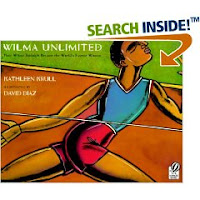
Bibliography
Krull, Kathleen. 1996. WILMA UNLIMITED. III. by David Diaz. San Diego: Harcourt Brace. ISBN 0152012672
Plot Summary
Wilma Rudolph was born a small, sickly baby who at the age of five had been stricken with polio. Wilma fought the disease, but was left with a paralyzed leg. Wilma’s determination did not hold her back. For years she went to the doctors and exercised her leg and at the age of twelve, Wilma was able to walk again. In fact, Wilma was the basketball star in high school leading her team to the state championship. It was there that a college coach from Tennessee State University saw what a fast runner she was and offered her a full scholarship. Wilma was the first in her family to go to college. At the age of twenty, Wilma traveled to Rome and was “the first African woman to win three gold medals at a single Olympics.”
Critical Analysis
In this storybook biography for young readers, Krull was able to tell the beautiful story of how Wilma Rudolph overcame the challenges in her life. Not only was she born very sick and soon paralyzed by polio, Wilma also was growing up during times of segregation. Krull describes these obstacles that she endured throughout the story. In one instance, Krull shares how Wilma and her mother had to travel to Nashville “some fifty miles away” because that hospital was the closest one around that would treat black people. “They rode together in the back, the only place blacks were allowed to sit.” The story was both engaging and easy to read, and Krull creatively captured the most pivotal points that lead up to Wilma’s Olympic victory.
Diaz chose acrylics and watercolors to create the striking illustrations used in the book. These brightly colored illustrations were then mounted onto sepia photographs. Images of a wooden fence, a basketball net, a gravel track, and a bus tire are just a few of the images used to frame the illustrations as photographic backdrops. For example, when Wilma was able to take off her brace for good, Wilma and her mother “wrapped the hated brace in a box and mailed it back to the hospital.” To frame the watercolored image of Wilma and her mother boxing up the brace Diaz used a sepia-toned photograph of a box with paper shavings and the word “fragile” written all over the box. This multi-leveled art will leave readers going back several times to view the photographs again.
Krull has inserted an Author’s Note at the end of the book that describes how her town gave her a parade and banquet to honor her medals, a bit of information about the polio disease, and what Wilma did after she retired from her running career. This along with the story of Wilma Rudolph will only leave kids begging for more on the history of her life. Krull’s story of Wilma Rudolph is both informative and inspirational.
Review Excerpt
Booklist review: “Both Krull's words and Diaz's illustrations are celebrations of an inspiring life that deserves to be remembered.”
Publishers Weekly review: “This juxtaposition yields busy, effectively textured pages, flawed only by the text's curiously embellished font-the letters look as though they have been speckled with either ink blots or dust. A triumphant story, triumphantly relayed.”
Connection
Other books written by Kathleen Krull include:
Krull, Kathleen. A WOMAN FOR PRESIDENT: THE STORY OF VICTORIA WOODHULL. ISBN 080279615X
Krull, Kathleen. POCAHONTAS: PRINCESS OF THE NEW WORLD. ISBN 0802795552
Krull, Kathleen. LIVES OF EXTRAORDINARY WOMEN: RULERS, REBELS (AND WHAT THE NEIGHBORS THOUGHT). ISBN 0152008071

1 comment:
awesome
Post a Comment